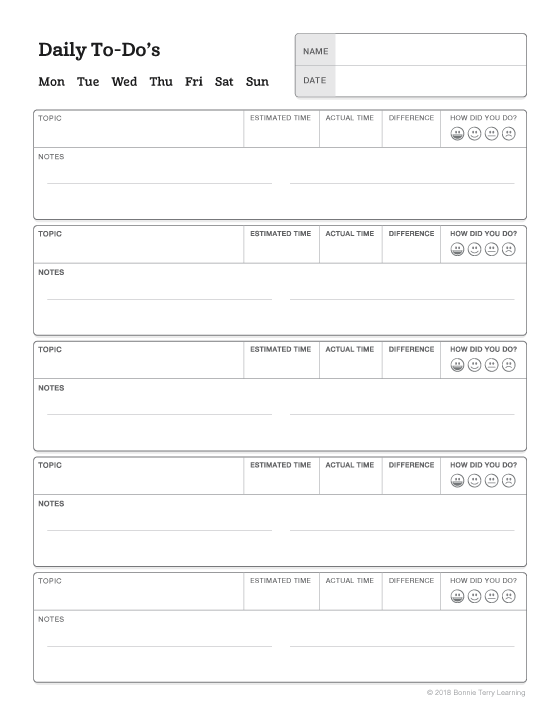Use these for your daily reminders. Choose the form that works best for you. One has the time frame listed on the side, and the other is free-form.
Goal Planning
Set Your Goals
One of the first things you need to do when you are on the journey to improve your writing or study skills is to set goals. When you have a plan, it makes it much easier to succeed. This graphic organizer will help you visualize the steps you need to take to accomplish a goal.
Think of climbing a mountain. To get to the top of the mountain (the goal), you have some steps to take. You may run into a few boulders along the way, but you can hike around them and still get up the mountain! If you need help, you can refer to your “map” (the numbered steps in the template), or ask a friend or teacher for help.
Monthly Planner
Monthly Plan
How Do You Currently Spend Your Time? Start mapping how you have used your time over the past month from a more general, birds- eye view. There are two different monthly calendars to choose from. The rest have free-flowing sections that can be used for the same activity across multiple days. The second has defined slots for different activities for each time frame. After you have mapped your previous month to visualize how you have been currently using your time, make a plan for the current month. For each month, map the next month at the end of the current, so that you will have a fresh start and know what you need to do the first of the next month.
Business Letter Writing
Writing a Business Letter
Here are some Graphic Organizers to help with formal business letter writing. These formats are widely accepted as the standard.
Changing the Business Letter to a Friendly Letter:
If you are writing a friendly letter, you do not need to include a company address. For the friendly letter, use the second Business Letter form (without the business address, and you also do not need to type your name under your signature). In the friendly letter, you may also indent the first line of the body of the letter.
Universal Organizers
Universal Organizers
These forms are more free-form, so they can be adapted for different uses. These can be used for note-taking, planning, or just organizing your thoughts and ideas. These forms can help you visualize and prioritize hard to resolve thoughts and ideas for project planning and more.
Daily Schedule
Daily Schedule and Reminders
Use these for scheduling your day. Choose the form that works best for you. One has the time frame listed on the side, and the other is free-form.
Weekly Planner
Weekly Plan
How Do You Currently Spend Your Time? Start mapping how you have used your time over the past week from a more general, birds- eye view. There are two different weekly calendars to choose from. The rest has free-flowing sections that can be used for the same activity across multiple days. The second has defined slots for different activities for each time frame. After you have mapped your previous week to visualize how you have been currently using your time, make a plan for the current week. Each week, map the next week on Friday so that you will have a fresh start and know what you need to do come Monday.
Priority Planning
Priorities are activities we may categorize as what we need to do, would like to do, or would like to do if we have time. Outline your priorities, restate them as goals, and describe how you are going to accomplish them. This process makes your priorities concrete and more achievable.
Think in terms of:
- Things you have to do.
- Things you really enjoy and want to do.
- Things that if you get to them it is great, but if not it is still okay.
Daily Todo’s
This graphic organizer form is great for planning and developing executive function skills.
Use these forms to list assignments, tasks, or projects that you need to work on daily. Depending on your needs, choose a form more or less area for notes on each task.
- Circle the day.
- In the topic space, write the assignment, task, or subject.
- In the notes section, write the assignment or task in detail. It helps to use verbs or actions that you need to do in order to accomplish the task.
- Estimate how much time it will take you to complete the task.
- Use a timer or keep track of the time with a clock while you are working on the task.
- After completing the assignment, note how much time it actually took you to complete.
- What is the time difference between how much time you estimated and how much time it actually took you? Did you under or overestimate time? Consistently noting this difference will help you better estimate time in the future.
- How did you do? Are you ecstatic, happy, okay, or sad about how you did?

